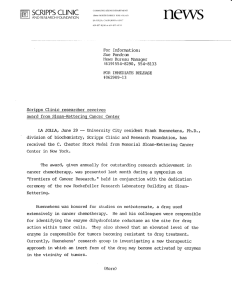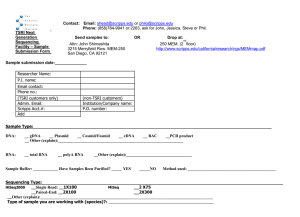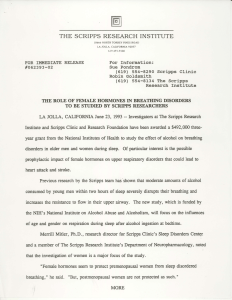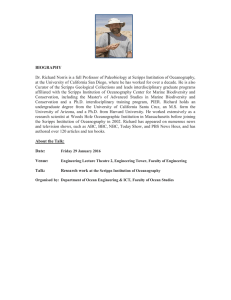M SCRIPPS DISCOVERS Scripps Research Scientists Illuminate Structure of Circulating Lung Cancer Cells
advertisement
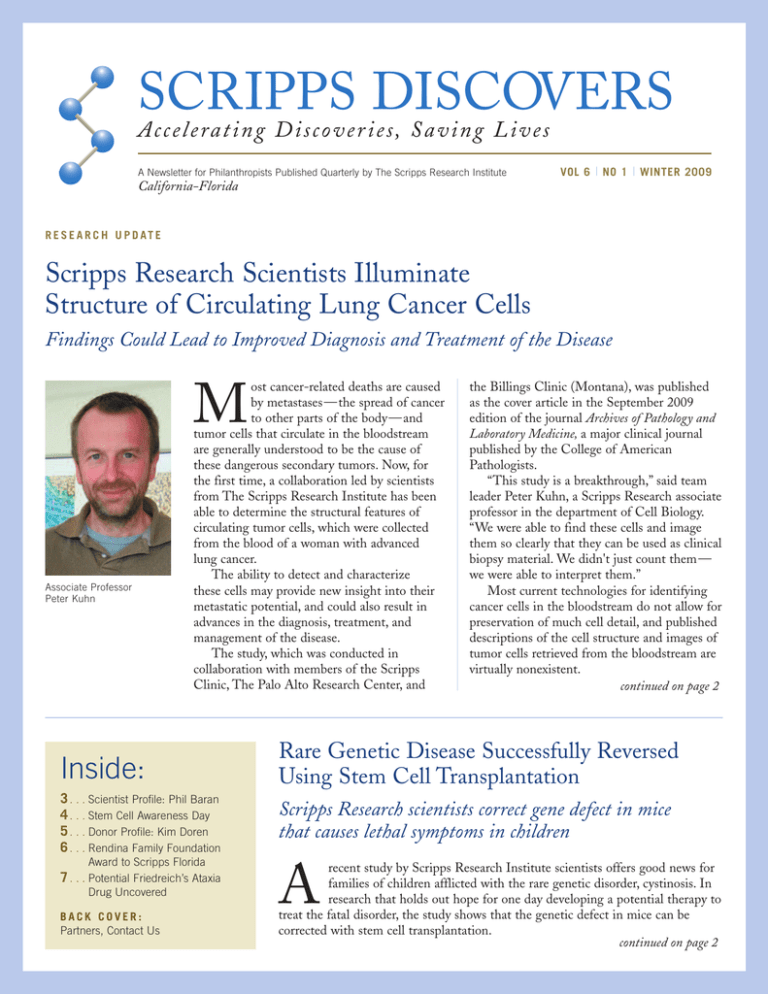
SCRIPPS DISCOVERS Ac cel e ra tin g D is co ve r i es , S a v i ng L ive s A Newsletter for Philanthropists Published Quarterly by The Scripps Research Institute VOL 6 | NO 1 | WINTER 2009 California-Florida R E S E A R C H U P D AT E Scripps Research Scientists Illuminate Structure of Circulating Lung Cancer Cells Findings Could Lead to Improved Diagnosis and Treatment of the Disease ost cancer-related deaths are caused by metastases —the spread of cancer to other parts of the body —and tumor cells that circulate in the bloodstream are generally understood to be the cause of these dangerous secondary tumors. Now, for the first time, a collaboration led by scientists from The Scripps Research Institute has been able to determine the structural features of circulating tumor cells, which were collected from the blood of a woman with advanced lung cancer. The ability to detect and characterize these cells may provide new insight into their metastatic potential, and could also result in advances in the diagnosis, treatment, and management of the disease. The study, which was conducted in collaboration with members of the Scripps Clinic, The Palo Alto Research Center, and M Associate Professor Peter Kuhn the Billings Clinic (Montana), was published as the cover article in the September 2009 edition of the journal Archives of Pathology and Laboratory Medicine, a major clinical journal published by the College of American Pathologists. “This study is a breakthrough,” said team leader Peter Kuhn, a Scripps Research associate professor in the department of Cell Biology. “We were able to find these cells and image them so clearly that they can be used as clinical biopsy material. We didn't just count them— we were able to interpret them.” Most current technologies for identifying cancer cells in the bloodstream do not allow for preservation of much cell detail, and published descriptions of the cell structure and images of tumor cells retrieved from the bloodstream are virtually nonexistent. continued on page 2 Inside: Rare Genetic Disease Successfully Reversed Using Stem Cell Transplantation 3 . . . Scientist Profile: Phil Baran 4 . . . Stem Cell Awareness Day 5 . . . Donor Profile: Kim Doren 6 . . . Rendina Family Foundation Scripps Research scientists correct gene defect in mice that causes lethal symptoms in children Award to Scripps Florida 7 . . . Potential Friedreich’s Ataxia Drug Uncovered BACK COVER: Partners, Contact Us recent study by Scripps Research Institute scientists offers good news for families of children afflicted with the rare genetic disorder, cystinosis. In research that holds out hope for one day developing a potential therapy to treat the fatal disorder, the study shows that the genetic defect in mice can be corrected with stem cell transplantation. continued on page 2 A Circulating Lung Cancer Cells, CONTINUED “In fact, I know of no existing detailed descriptions of lung cancer circulating tumor cells at all,” said Kuhn. “So this really is a significant achievement in validating a blood sample biopsy.” To uncover the structure of these circulating tumor cells, Kuhn used a previously published methodology called fiber optic array scanning technology or FAST. Kuhn and his laboratory colleagues developed the basic technology in 2004. “That earlier study published in Human Pathology, which was done on breast cancer, established for first time that the cells we found in circulation were very similar to the cell types in the primary tumor,” he said. “Now we have shown similar findings for lung cancer for the first time — but with far better results.” In the new study, Kuhn and his colleagues determined the cytomorphology of circulating tumor cells four years after the patient was diagnosed Stem Cell Transplantation, with her disease. The scientists identified some 67 circulating tumor cells in blood samples. When compared with the original tissue biopsy, there were a striking number of similar features between the circulating tumor cells and the biopsy cells, including a large size in comparison to standard white blood cells. “Circulating tumor cell detection and characterization could aid in the development of individualized treatment strategies ...” Kelly Bethel, a pathologist with the Scripps Clinic and adjunct professor at Scripps Research who worked on the study, noted, “Because the patient's cancer cells partially resemble benign lung cells but are in the abnormal location of the bloodstream, they are quite distinct, and because our imagery is so sharp, we could compare the circulating tumor cells to primary biopsy cells quite easily. The next challenge is to see if we can characterize how the appearance and structure of these circulating tumor cells change over time and with treatment.” Circulating tumor cell detection and characterization could aid in the development of individualized treatment strategies, Kuhn suggested, and a number of publications have already described the impact of the number (or change in number) of detectable circulating tumor cells on patient response to therapy. “This is the first time that our work has been recognized by a major clinical audience, the people who do this work for real,” said Kuhn. “This represents a huge step forward for us in terms of their acceptance and opens the door to potential applications of our approach.” Additional imagery and follow up data can be found at http://cancer.scripps.edu. CONTINUED “After meeting the children who suffer from this disease, like an 18-year-old who has already had three kidney transplants, and the families who are desperately searching for help, our team is committed to moving toward a cure for cystinosis, a lysosomal storage disorder. This study is an important step toward that goal.” — Stephanie Cherqui, Assistant Professor In the study, the Scripps Research team used bone marrow stem cell transplantation to address symptoms of cystinosis in a mouse model. The procedure virtually halted the cystine accumulation responsible for the disease and the cascade of cell death that follows. Cystine is a byproduct of the break down of cellular components the body no longer needs in the cell’s “housekeeping” organelles, called lysosomes. Normally, cystine is shunted out of cells, but in cystinosis a gene defect of the lysosomal cystine transporter causes it to build up, forming crystals that are especially damaging to the kidneys and eyes. While cystinosis is rare—affecting an estimated 500 people in the United States and 2,000 worldwide—it is devastating. Three types of cystinosis have been described based on the age at diagnosis and the amount of cystine in continued on page 3 2 | SCRIPPS DISCOVERS WINTER 2009 SCIENTIST PROFILE Phil Baran: Converting Compounds Derived From Nature to New Drugs > Scripps Research Professor Phil Baran is driven by the desire to create, the exhilaration of discovery, and ultimately saving lives. t an age when most researchers’ careers are just ramping up, the 32-year old is already a standout in the field of organic chemical synthesis, making great strides in developing innovative ways to synthesize chemicals well. His laboratory’s work has already advanced an array of biomedical studies by synthesizing promising potential drugs and creating new chemicals. As the candidate drug pipelines at major A Stem Cell Transplantation, pharmaceutical companies are drying up, it could be increasingly important to explore new compounds derived from nature as potential new drugs. A range of drugs from aspirin to the widely used cancer treatment Taxol have been discovered in nature, but the complexity of producing natural products has made some companies reluctant to focus on them. “Natural products have an unparalleled track record in the betterment of human health,” said Phil. “In fact, nine of the top 20 bestselling drugs were either inspired or derived from natural products. Even the best-selling drug of all time, Lipitor, was based on a continued on page 4 “We focus on inventing new science and exploring uncharted realms of chemistry. . . . That’s the idea. That is our passion.” — Professor Phil Baran CONTINUED cells: infantile onset, adolescent onset, and adult onset. Children as young as six months can begin to suffer renal dysfunction, which grows progressively worse with time. Other symptoms include diabetes, muscular disease, neurological dysfunction, and retinopathy. Infantile onset is the most common, as well as the most severe, form of the disease. The only available drug to treat cystinosis, cysteamine, while slowing the progression of kidney degradation, does not prevent it, and end-stage kidney failure is inevitable. “Cysteamine must be given every six hours, so children have to be woken up each night to take this drug, which has unpleasant side effects, and many others to treat various symptoms,” Cherqui says. “So although there is treatment, it is difficult treatment that does not cure the disease.” In the new study, the researchers found that transplanted bone marrow stem cells carrying the normal lysosomal cystine transporter gene abundantly engrafted into every tissue of the experimental mice. This led to an average drop in cystine levels of about 80 percent in every organ. In addition to preventing kidney dysfunction, there was less deposition of cystine crystals in the cornea, less bone demineralization, and an improvement in motor function. “The results really surprised and encouraged us,” says Cherqui, who as a doctoral student in France in 1998 helped discover the gene involved in cystinosis. “Because the defect is present in every cell of the body, we did not expect a bone marrow stem cell transplant to be so widespread and effective.” Cherqui, who generated the mouse model in 2000 that is currently used to study cystinosis, says that adult bone marrow stem cell therapy is particularly well suited as a potential treatment for cystinosis because these cells target all types of tissues. In addition, stem cells reside in the bone marrow for the duration of a patient’s life, becoming active as needed, a particular benefit for a progressive disease like cystinosis. The work of Cherqui and her colleagues may have wider applications for other genetic diseases, providing proof of principle that adult stem cell transplants may be successful in humans for genetic diseases with systemic defects, especially those of a progressive nature. Cherqui expects to spend the next several years analyzing the safety of genetically modified autologous (obtained from the same individual) bone marrow transplants in the cystinosis mouse and other models before moving on to human clinical trials. This work was funded by the Cystinosis Research Foundation. SCRIPPS RESEARCH INSTITUTE | 3 Phil Baran, CONTINUED natural product lead — and it has helped prolong many lives.” Phil and his team have developed new techniques that dramatically reduce the time, complexity, and cost of synthesizing natural products with pharmaceutical potential. Their work dislodges previously entrenched beliefs in the organic chemistry field about how such products must be produced, and could help to advance and expand the use of natural products in drug discovery programs. “There is this far-ranging and damaging perception that natural products are too complex to be used in a drug discovery setting despite their overwhelming track record in medicine,” said Phil. “I think if our work has helped in even a small way to revive the use of natural products, then we’ve served our purpose.” “We focus on inventing new science and exploring uncharted realms of chemistry,” said Phil. “That’s the idea. That is our passion.” Target molecules often show great promise but come from sources that would be difficult or impossible to collect in sufficient quantities to support initial studies of their efficacy as disease treatments, much less in the quantities needed to support clinical trials. Short of decimating a marine ecosystem, researchers can typically only isolate milligrams of a given natural product from marine species. In contrast, Phil’s work often leads to the production of gram quantities of these products. In some cases, other research groups have been able to reveal a product’s medical bioactivity only because he has produced the synthetic product. Phil has collaborated with Genentech on compounds isolated from a sea squirt, or marine tunicate, showing potential for killing colon cancer cells in laboratory experiments. The natural supply of these molecules, known as the haouamines, was drained and only through total synthesis could 4 | SCRIPPS DISCOVERS WINTER 2009 the biological activity be explored. He and his colleagues, through some inventive steps, also established the first technique to synthesize kapakahines. These marine-derived natural products isolated from a South Pacific sponge in trace quantities, have shown anti-leukemia potential. Phil’s group synthesized kapakahines in large quantities, more than a decade after their discovery. With supplies now in hand, and unlimited production potential established, research on the compound can proceed and may eventually lead to new drug treatments. This is currently being pursued with pharma giant Bristol-Myers Squibb. His team of scientists has also developed an inexpensive and in many ways astonishing new method for economically producing a pharmaceutical steroid. The molecule, called cortistatin A, which was isolated in 2006 from a marine sponge discovered over 100 years ago, has shown huge promise for treating conditions ranging from macular degeneration to cancer. The achievement marked the finish line in a race that saw numerous research laboratories working to accomplish the feat. “Synthetic chemistry is something like mountain climbing except rather than simply reaching a new peak that nobody has climbed before, you are also inventing new harnesses, ropes, and climbing tools as you go. And you are finding ways to ascend with fewer steps than anyone has ever done before.” “It’s very difficult and very rewarding,” said Phil. “You have do develop new tools as the dynamics are constantly fluctuating. Invention is a prerequisite for success.” continued on page 5 Stem Cell Awareness Day Brings Visitors The Loring lab hosted an open house September 24 in honor of Stem Cell Awareness Day. Here, Kyle Nickey demonstrates a technique for visitors from the Juvenile Diabetes Research Foundation. Phil Baran, CONTINUED Phil found his passion for creating early on. “In high school I discovered the joy of mixing things to see what happens and eventually found out you can get paid for doing that — and help humanity at the same time” he said. Phil received his graduate degree right here at Scripps Research in the Kellogg School of Science and Technology. “Phil was a phenomenal student at Scripps Research — tenacious, enthusiastic, brilliant, imaginative, and so much more,” said Scripps Research Professor K.C. Nicolaou, Chair of the Chemistry Department. While Phil finds the discoveries that result from his research a high point, he says he counts success as a teacher as the greater prize. “For me, the most exciting and rewarding thing has been watching students go from naïve and not so focused to brilliant, independent researchers who are creative, imaginative, and able to think outside the box,” he said. “That has been the best.” Most of the students in his lab spend at least 12 hours a day at work — but they say the benefits are clear in terms of thinking of problems in new ways. Phil is a firm believer in the need for philanthropy at Scripps Research. “We rely on philanthropy to survive. We don’t have a billion dollar endowment here and can’t rest on our laurels. We need to make discoveries or we’ll be gone. Philanthropists to Scripps Research are getting a high value for their contributions as their funds are not going into some treasure chest — instead they’re going directly to the education of graduate students or for groundbreaking research. There is no bureaucracy or red tape here — we work freely and unencumbered on days, nights, and weekends — and no one can stop us. As chemists, we can impact the lives of millions of people.” DONOR PROFILE Kim Doren: Actively Broadening Scripps Research’s Support in the Community La Jolla resident Kim Doren is a charismatic Scripps Research supporter committed to the organization and its life-saving work. Kim, an annual contributor to Scripps Research who has included the organization in her estate plans, is also an active volunteer working to broaden Scripps Research’s outreach among donors and in the community. Kim has an extensive background as a communications, marketing, and advertising executive in the golf industry. Through Kim’s leadership and marketing skills, she played a key role in developing and implementing a recent survey of Scripps Research donors on planned giving, and in putting together a planned giving seminar for donors and prospective donors. “I’m really pleased to put my marketing skills to use to help Scripps Research in the community,” said Kim. Kim was first introduced to Scripps Research by scientist Jeffery Kelly six years ago, and attended several Scripps Research events about the same time. “My minor from Stanford is in human biology,” said Kim. “I was fortunate to be educated by top professors who shared cutting edge medical research with us. I found it fascinating. Although I can’t save the world in my day-to-day career, I feel I can make a huge impact through supporting Scripps Research and the incredible science performed there. I’m a huge fan of the Scripps Research scientists. They do heroic work.” “I’m also a firm believer in basic research — great discoveries that can treat human diseases are often made while scientists are looking for something else. It’s a shame that more people do not support basic research.” Kim is the co-author of several books with Charlie Jones, the late NBC sportscaster, including You Go Girl!, The Winning Way, That’s Outside My Boat: Letting Go of What You Can’t Control, and Heaven Can Wait: Surviving Cancer. “The books were really fulfilling,” said Kim. “It was great to follow up You Go Girl with a speaking tour that inspired young women, and I’m sure that our cancer book was helpful to many who have been afflicted with this devastating disease.” Kim is very involved in the community. She serves on the UC San Diego Athletic Board, and is involved with both the San Diego Foundation and the Foundation of La Jolla High School. “My parents were always active in nonprofit organizations and they instilled the value of volunteering in me,” said Kim. “We are so fortunate to have Kim as a donor and advocate,” said Wendy Scott Keeney, Vice President of Philanthropy. “She is a consistent supporter dedicated to the important mission of Scripps Research and helping us grow.” SCRIPPS RESEARCH INSTITUTE | 5 AWARDS AND HONORS Rendina Family Foundation Awards $150,000 Grant to Scripps Florida Scientist > The Rendina Family Foundation has awarded a $150,000 grant to Derek Duckett, an associate scientific director with the Translational Research Institute at Scripps Florida, a division of The Scripps Research Institute. he two-year award will support the salary and of infiltrating tumor cells to disperse into distant brain tissue. training of a postdoctoral scientist working on Recently, in vitro experiments done by Duckett and his potential treatments for glioblastoma, an aggressive colleagues have shown that inhibiting JNK in glioblastoma cells, by either genetic modification or the use of small form of brain cancer. molecule inhibitors, dramatically inhibits both glioblastoma “I am delighted to receive this grant from the Rendina cell migration and invasion. Foundation,” Duckett said. “Our laboratory has recently Duckett hopes his research program will lead to a better developed several novel tools to help understand certain understanding of the role that uncontrolled JNK signaling critical aspects of this disease, so the help couldn’t come at a plays in the migration and invasion of glioblastoma cells, as more perfect time. This funding will enable us to generate well as illuminating potential treatment options. some critically important proof-of-principle studies for “We have reached the stage in our potential new glioblastoma therapies.” discovery efforts that our small molecule Glioblastoma multiforme, the most “The death of my father and JNK inhibitors have desirable drug-like malignant form of the disease and the the recent death of Senator properties,” Duckett said, “and we plan most common, are tumors that form Kennedy from this cancer to study the efficacy of these molecules from glial cells, which support and show just how far we have to in glioblastoma tumor models. This protect neurons in the brain and spinal generous grant from the Rendina cord. Treatment options are extremely go in finding new treatments. Foundation will help us go one step limited and patients with the disease Derek’s research represents further in terms of advancing novel usually die within a year of diagnosis. the kind of innovative treatments — to see how our small The primary reason for this grim science that we need in the molecule inhibitors might enhance the prognosis is the complexity of the tumor action of other therapies such as itself, which is why the work of scientists fight against cancers like chemotherapies and radiation.” like Duckett and the support of giablastoma, so that one day Bruce Rendina and his wife Marji philanthropies like the Rendina Family we can finally put an end established the Rendina Family Foundation are so important. to this terrible disease.” Foundation in 1997. “We are pleased to support the work Rendina was a recognized leader in of scientists like Derek and his colleagues — Michael Rendina the healthcare industry, founding the at Scripps Florida,” said Michael Rendina Companies, a full-service medical real estate Rendina, the foundation’s president. “The death of my father development firm. Since his death in 2006 from brain cancer, and the recent death of Senator Kennedy from this cancer his family has led the foundation’s work. show just how far we have to go in finding new treatments. The Rendina Family Foundation strives to enhance the Derek’s research represents the kind of innovative science quality of life for families and individuals who have been that we need in the fight against cancers like glioblastoma, so affected by cancer. They endeavor to accomplish this through that one day we can finally put an end to this terrible the funding of organizations, hospitals and biotechnology disease.” companies that excel in researching and developing cures for In his work, Duckett and his colleagues have focused on cancer. In addition, they support efforts to increase the the Jun-N-terminal kinase or JNK as a potential treatment target for this virulent form of cancer. general welfare of the communities in which the foundation is actively involved. The JNK kinases are enzymes involved in a range of cellular signaling pathways, and have been implicated in Since its inception, the Rendina Family Foundation has donated more than $4 million to organizations nationwide. The important processes including metabolic reactions, gene inaugural “Raising the B.A.R.” Bruce A. Rendina Memorial Golf regulation, and cell proliferation — all areas where any Tournament was held in May 2007. This annual tournament significant disruption can lead to cancer, diabetes, or commemorates the life and legacy of one of the country’s most inflammatory disease. accomplished real estate developers and philanthropists. For For glioblastoma, the single most important factor in the more information, visit www.rendinafamilyfoundation.com. virtually unstoppable progression of the disease is the ability T 6 | SCRIPPS DISCOVERS WINTER 2009 Potential Friedreich’s Ataxia Drug Uncovered > Using clever chemistry, a Scripps Research team has pinpointed the enzyme target of a drug group that stops the progression of the devastating disease Friedreich's ataxia in mice and may do the same for humans. he findings, developed in collaboration with scientists from Repligen Corporation, help advance this treatment approach one step closer toward human clinical trials, which will be a welcome event for disease sufferers who currently have few treatment options. The work could also lead to treatments for related conditions such as Huntington’s disease and the spinocerebellar ataxias. “It will be very rewarding if our work actually leads to a therapy for Friedreich’s,” says Joel Gottesfeld, a professor in the Department of Molecular Biology and leader of the Scripps Research team that discovered the potential treatment. “This is a horrible disease.” Friedreich’s ataxia, which afflicts about one of every 20,000 to 50,000 people in the United States, is caused by inadequate production of the protein frataxin, which leads to degeneration of nerve tissue and an array of associated complications including heart disease and scoliosis. In most cases, sufferers are ultimately confined to a wheelchair and many die as young adults. Researchers have tied this low frataxin production to a large repetition of a specific triplet DNA pattern in the frataxin gene. Though many questions remain open, it appears that the unusual DNA structure resulting from these repetitions somehow attracts enzymes known as histone deacetylases (HDACS). These enzymes alter the packaging of the DNA in chromosomes in a way that inactivates the expression of the frataxin gene, though it remains intact. In 2006, the Gottesfeld team reported the discovery of a compound simply called 4b that blocked HDAC T activity, jumpstarting frataxin production in white blood cells from Friedreich’s patients. Later work showed that a close derivative of 4b increased the level of frataxin production in a mouse model for Friedreich’s ataxia. path, that can control the production of the frataxin protein. With that identified, the scientists are better positioned to understand what’s causing the disease. Having such information about the mechanism of a potential drug “It will be very rewarding if our work actually leads to a therapy for Friedreich’s . . . This is a horrible disease.” — Professor Joel Gottesfeld But researchers remained unsure of how these molecules work, and understanding a drug’s activity is critical to moving forward with drug development, as well as to gaining better understanding of a disease. To answer that question, Chunping Xu, a postdoctoral research associate in Gottesfeld’s lab, drew on work by Scripps Research Professors Barry Sharpless and Ben Cravatt and their groups. Using a technique referred to as “click chemistry” and other methods, Xu combined 4b with a fluorescent tag, resulting in a compound called 1-BP. She then incubated this creation with samples of various HDACs. If the enzyme or enzymes targeted became fluorescent, she would know it was due to binding with 1-BP. The results were unequivocal. “This molecule has just an astonishing preference for HDAC3 over any of the other HDAC enzymes,” says Gottesfeld. Related experiments with 1-BP and extracts from Friedreich’s patients’ cells, and other tests done by Repligen confirmed HDAC3 as the target. HDAC3 is part of a whole family of HDACs (at least 18) that could have been involved. By identifying the one that’s playing a key role, the scientists have revealed the path, or at least a treatment is also critical to understanding what effects a drug might have on patients. The Gottesfeld team’s work was completed in collaboration with researchers from Repligen Corporation, based in Waltham, MA, which is pursuing a Friedreich’s treatment suitable for human clinical trials. But the Scripps Research team’s work isn’t done. Gottesfeld and his colleagues will continue to study HDAC3 and its inhibitors in hope of identifying exactly how this enzyme controls frataxin production, and whether it directly or indirectly inactivates the frataxin gene. Such work could help researchers better understand how Friedreich’s and similar diseases such as Huntington’s progress, improving the chances of effective treatments. “When you delve deeper into the mechanisms,” says Gottesfeld, “You never know if you might uncover new targets and new therapeutic interventions that are even better than what you’re working with.” This research was supported by the National Institute of Neurological Disorders and Stroke of the National Institutes of Health, the Friedreich’s Ataxia Research Alliance, GoFAR, Ataxia UK, and Repligen Corporation. SCRIPPS RESEARCH INSTITUTE | 7 Partners 1 Scripps Research Professor Dennis Burton is leading the HIV Neutralizing Antibody Center, a $30 million partnership between Scripps Research and the International AIDS Vaccine Initiative (IAVI). The Center recently announced that it has identified two potent antibodies that could supercharge the quest for a broad-based AIDS vaccine. In September, 100 international AIDS researchers gathered at Scripps Research for a symposium to discuss the vaccine possibilities of broadly neutralizing antibodies. The day included a dinner in which Burton and IAVI President Seth Berkley spoke to a small group of San Diego-area community leaders at the home Scripps Research Trustee Gary Coburn and his wife Carol, as part of an effort to get local residents involved with the successes taking place in their backyard. Pictured at the dinner are Gary and Carol Coburn and Robert Horsman, President/CEO of San Diego National Bank. (top left photo) Grand Del Mar Hotel. Pictured at the reception following the talk are David Strachan (center), who hosted the event with his wife, Tamia; flanked by Richard Keller (left) and Kathy Keller (right). (top right photo) Photo credit: Guided By Imagination Photography 3 2 Twenty Scripps Research supporters and friends attended a special collaborative seminar sponsored by Merrill Lynch’s Demmler, Wardein and Russell Group and Scripps Research in September. At the event, John Brown, a nationally recognized planned giving specialist, spoke on “Investing in the Future: The Financial Advantages of Planned Giving.” The event was held at the Third, fourth, and fifth grade students from Summit Montessori recently took part in hands-on experiments at a Scripps Florida Education Outreach “Wow Chemistry” event. The photo features students, teachers, and parents — all mentored by Kellogg School of Science and Technology graduate students and team leader Deborah Leach-Scampavia, Scripps Florida’s education and outreach administrator. (bottom photo) Contact Us: • For more information about Scripps Research, visit our web page at www.scripps.edu /philanthropy • To learn more about supporting Scripps Research’s cutting-edge research, please contact: CALIFORNIA (858) 784.7083 or (800) 788.4931 wkeeney@scripps.edu FLORIDA (561) 228.2013 abruner@scripps.edu
